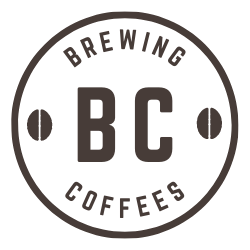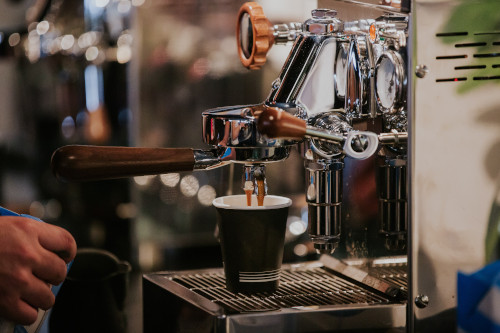There are many different devices you can use to make coffee. There are drip coffee makers, french press coffee makers, stovetop pots, and many more. But when you think of a coffee machine, you probably think of an espresso machine, with its complex-looking parts, buttons, and dials.
If you’re considering getting an espresso coffee machine for your home, then this complexity can be intimidating. But there’s no need to worry. It’s easy to learn the parts of a coffee machine and what they do.
What are the parts of a coffee machine?
The 9 key parts of an espresso machine are:
- Bean hopper
- Group head
- Portafilter
- Boiler
- Steam wand
- Hot water tap
- Pressure gauge
- Sight glass
- Drip tray
Let’s find out more about each of these parts and learn how they help to make the perfect coffee.
The 9 key parts of a coffee machine & what they do
From grinding your coffee beans to pulling a shot of espresso and adding water and steamed milk, these are the parts of a coffee machine that make the magic happen.
Bean hopper
The coffee bean hopper stores your fresh coffee beans until they are ready for grinding. Assuming your particular coffee machine features an integrated grinder, you will find a bean hopper on top of your machine.
Coffee bean hoppers are often conical or cylindrical, in order to feed the beans down into the grinder, and transparent so that you can see how many beans are left in your hopper and top them up when needed.
There is usually an adjustment dial on the side of the bean hopper, which allows the barista to choose whether they want coarse or fine ground coffee.
Group Head
The group head is a key component of an espresso machine, as it is where the hot, pressurized water emerges from your espresso machine and the last point before the water makes contact with your coffee grounds.
If your group head isn’t working as it should, you won’t get an even flow of water into your coffee grounds, and your coffee won’t brew correctly.
Portafilter
The portafilter is the detachable part of an espresso machine that holds the coffee grounds. Also known as a group handle, it is a spoon-like tool with a handle and a basket to hold the coffee.
Coffee grounds are pushed into the portafilter and compacted using a tamper. The compact circular block of coffee is known as a puck.
During the brewing process, hot water pours through the coffee grounds held within the portafilter.
There are many different types of portafilter, and they are not transferrable between different brands of espresso machine.
Some portafilters, usually found on entry-level machines, are pressurized to help pour a good espresso shot. However, this removes a lot of control from the barista.
Portafilters found on more professional espresso machines are not usually pressurized. This allows the barista to better control their shot by adjusting the grind size of the beans and the compactness of the puck.
Boiler
As you would expect, the boiler’s job in an espresso machine is to heat the water.
The boiler is needed to provide the hot water that passes through the coffee grounds to make an espresso shot, and to produce steam to pass through the steaming wand to steam and froth milk.
There are three types of boilers commonly found in espresso machines:
- Single boiler, dual-use
- Heat exchange
- Dual boiler
The difference is all about what tasks they can perform simultaneously.
A dual-use boiler can heat water to brew an espresso shot and can make steam to froth milk. However, it can’t do both at once.
Heat exchange boilers and dual boilers don’t have this problem. Both can simultaneously brew espresso and steam milk.
Steam wand
The steam wand is the small metal pipe that you see sticking out from an espresso machine.
Steam generated by the boiler flows out of the steam wand to allow the barista to steam and froth milk.
To do this, the barista takes a jug of milk and submerges the tip of the steam wand into the milk. They then hold the jug at the desired angle and the steam wand at the depth needed to create the consistency of milk needed for the type of coffee they are brewing.
Hot water tap
The hot water tap is a potentially misleading part of a coffee machine, and beginners should beware. This tap is not for making coffee!
As we’ve already explained, the hot, pressurized water needed to make your coffee comes out of the group head.
The hot water tap is for rinsing and cleaning cups, jugs, spoons, etc. It is not for brewing drinks.
Pressure gauge
Your espresso machine will include a pressure gauge that tells you the pressure of the water. This pressure will be measured in bars.
Generally speaking, higher pressure means better espresso. However, your machine will only be capable of pressurizing water up to a certain point.
A brewing pressure of around 9 bars is perfect for brewing a delicious shot of espresso.
One word of warning: Don’t be misled by cheaper espresso machines that advertise higher pressures – say, 15 bars – in an effort to sound like they will made a better shot.
These advertised pressures are often the pressure at the pump, not at the group head or the portafilter. These coffee machines will lose pressure between these stages, and your coffee will be brewed at 9 bars or less anyway.
It’s the pressure when the water meets your coffee grounds that matters.
Sight glass
The sight glass shows the barista how much water will be used to produce the steam from the steam wand.
The sight glass will show a minimum and maximum, and it is generally best to keep your water level about halfway between the two.
However, if you notice that your milk is not frothing properly, then you may want to adjust the water level. For example, lowering the water level will produce drier steam but will also reduce the pressure of the steam.
Drip tray
The drip tray is where you place your coffee cup when pouring your shot of espresso.
Ideally, you should choose an espresso machine with an adjustable height drip tray. This has two benefits: firstly, you will have enough space for different height coffee cups, and secondly, you can adjust the drip tray to ensure your espresso is pouring from the correct height.
If the gap between the group head and the drip tray is too large, your espresso could splash out of the cup, which of course, we do not want!
FAQ – The Different parts of a Coffee Machine
There are 9 key parts of an espresso machine:
1. Bean hopper
2. Group head
3. Portafilter
4. Boiler
5. Steam wand
6. Hot water tap
7. Pressure gauge
8. Sight glass
9. Drip tray
Portafilter! The portafilter is the detachable part of an espresso machine that holds the coffee grounds.
This is the filter basket. It is the basket inside the portafilter, where the coffee is ground into.

Hey there! I’m Austin and I love coffee. In fact, I drink about 5 americanos a day. I started BrewingCoffees because I wanted to share my love of coffee with the world. Before starting BrewingCoffees, I worked as a Barista for 7 years.


Leave a Reply